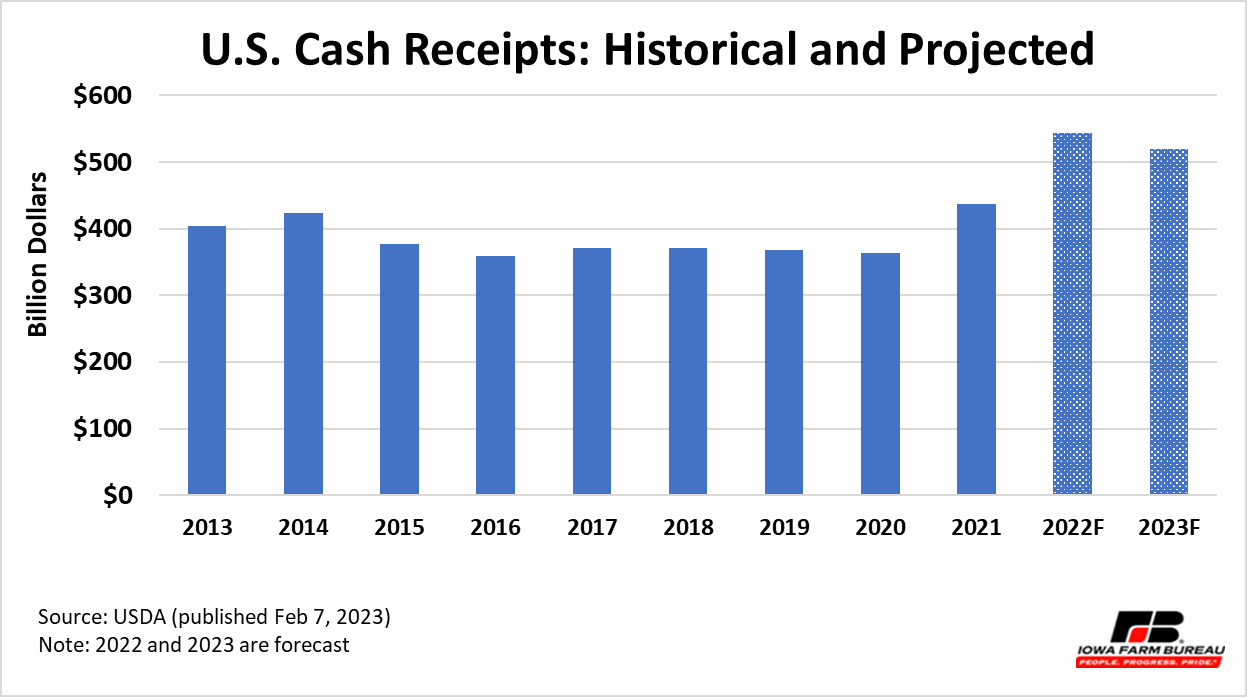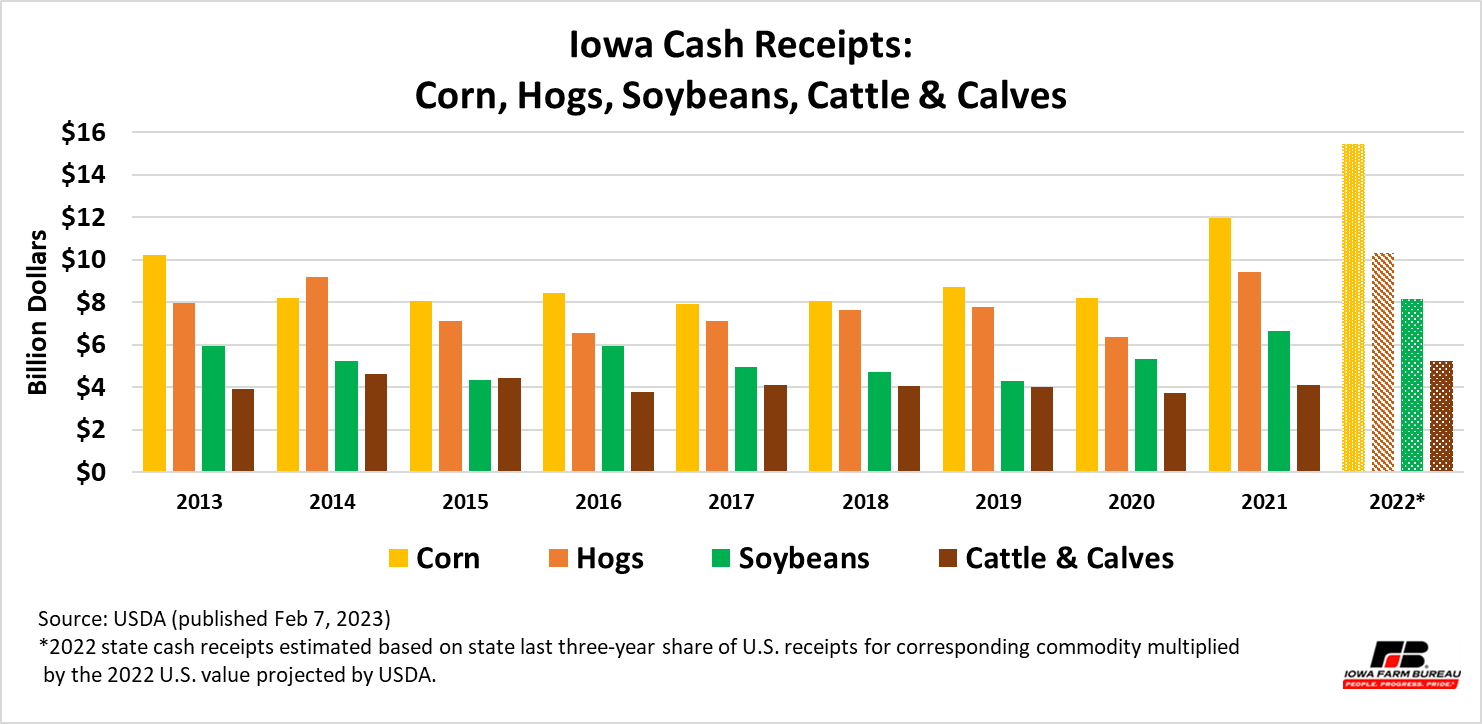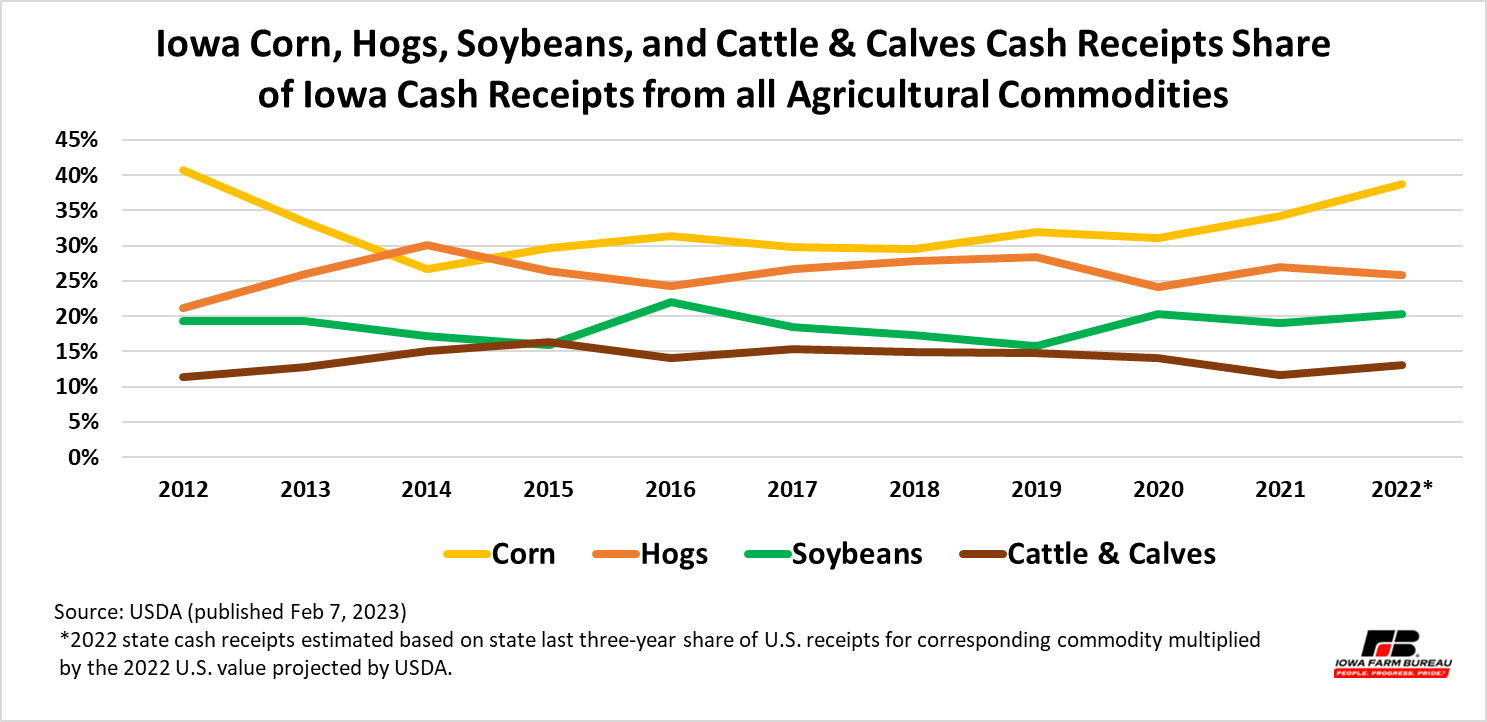USDA Forecasts a Decline in U.S. Farm Income in Calendar Year 2023
Author
Published
3/1/2023
According to USDA-ERS’s projections published February 7, 2023, after two year of continuous farm income growth, U.S. farm income is forecast to decline in 2023 calendar year. Net farm income[1] in 2023 is forecast down $25.9 billion to $136.9 billion compared with 2022. Net cash farm income is forecast to fall 20.7% to 150.6 billion in 2023 relative to 2022 .
U.S. cash income in 2023 calendar year is forecast to decrease 4.3% to $519.9 billion from the previous calendar year (Figure 1). Overall, crop receipts are expected to decline to $276.9 billion, down 3.1% from 2022[2]. According to USDA, U.S. corn cash receipts in 2023 calendar year are forecast to fall 4.5% to $85.8 billion despite expected larger quantities of corn sales due to expected lower prices. The forecast for U.S. soybeans cash receipts in 2023 indicates a reduction of 8.1% to $58.6 billion year-over-year, also due to anticipated lower prices.
In response to falling prices, 2023 U.S. hog cash receipts are forecast to decline 2.7% to $28.6 billion. In contrast, because of a forecast increase in prices, U.S. cattle & calves receipts are expected up 2.4% to $88.9 billion in 2023 compared with the previous calendar year estimate ($86.8 billion).
The latest Farm Income and Wealth Statistics data also includes the 2022 U.S. cash receipts forecast. The forecast indicates a growth of 24.4% to $543.4 billion from last year’s estimate. U.S. corn receipts in 2022 are forecast to grow by $17.8 billion (to $89.9 billion) from 2021, whereas receipts for U.S. hogs are forecast to expand by $1.4 billion (to $29.4 billion). 2022 sales for U.S. soybeans are forecast up $14.6 billion (to $63.7 billion) year-over-year. In addition, U.S. cattle & calves cash receipts are forecast at $86.8 billion, which would be up $13.9 billion from 2021.

Figure 1. U.S. Cash Receipts: Historical and Projected
Iowa Farm Income in 2022
USDA-ERS has not published yet the 2022 state cash receipt data. 2022 cash receipts for the top four commodities in Iowa (i.e., corn, hogs, soybeans, and cattle & calves) were estimated based on the last three-year average share of U.S. receipts for each of these commodities, multiplied by the corresponding 2022 U.S. sales projected for each of these commodities. Iowa’s corn, hogs, soybeans, and cattle & calves receipts in 2022 were estimated at $15.5 billion, $10.3 billion, $8.1 billion, and $5.2 billion, correspondingly (see Figure 2). These estimates indicate 2022 receipts, compared with the previous calendar year, are up 29% for corn and 9.5% for hogs. In the case of soybean and cattle & calves receipts, cash receipt are up 22.3% and 27.2%, respectively, from the earlier calendar year.

Figure 2. Iowa Cash Receipts: Corn, Hogs, Soybeans, Cattle & Calves
On average, Iowa’s cash receipts from corn, hogs, soybeans, and cattle & calves made up 91% percent of total farm cash receipts in the state from 2012 to 2021. Corn and hogs cash receipts accounted for 32% and 26% of total state cash receipts during this 10-year period (see Figure 3). Soybeans and cattle & calves cash receipts represented 18% and 14% of Iowa total cash receipts, respectively.

Figure 3. Iowa Corn, Hogs, Soybeans, and Cattle & Calves Cash Receipts Share of Iowa Cash Receipts from all Agricultural Commodities
If the 2023 forecast for cash income reduction at the national level is realized, Iowa cash receipts would decline as well, particularly cash receipts from corn, hogs, and soybeans, which are the top three agricultural commodities in the state. Note that the current forecast presented here (USDA-ERS’s February forecast) uses the current year’s commodity price forecast from USDA-ERS’s agricultural baseline report (long term projections). However, the next publications (August and November releases) of farm income forecasts use the August and November WASDE midpoint price for WASDE crop commodities, including prices for corn and soybeans, which most likely will modify the current forecast.
[1] Net farm income is a broad measure of profits.
[2] USDA-ERS’s February forecast are based on current year’s commodity price forecast from USDA-ERS’s agricultural baseline report. Farm income forecasts for the August and November releases use the August and November WASDE midpoint price for barley, corn, upland cotton, oats, rice, sorghum, soybeans, and wheat.
Economic analysis provided by Patricia Batres-Marquez, Senior Research Analyst, Decision Innovation Solutions on behalf of Iowa Farm Bureau.
Want more news on this topic? Farm Bureau members may subscribe for a free email news service, featuring the farm and rural topics that interest them most!